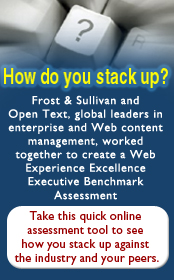| |
 |
|
JUNE
2010 | VOL. 3 | ISSUE 1 |
|
CONNECT |
 |
 |
 |
 |
|
|
 
INSIDER EXPERTISE
Measuring Effective ROI,
for Web Excellence
 |
|
When companies make the investment to improve their customers’ Web experience, the first, most inevitable question decision-makers ask is, “What is the ROI?” When it comes to investing back into your site, measuring ROI in an efficient way is a science of metrics, with results calculated in pure cash value.
Some of the most important variables to measuring ROI include:
• Entrance Bounce Rate: visitors lost after entrance on each page.
(The universal objective is to keep this rate as low as possible.)
• Entrance Page Traffic: where visitors go when they click on your
site,and how often they come back.
• Penetration: Visitors going beyond the home page, as in depth on the
site as possible (the obvious objective is to keep this rate as high as
possible).
• Duration: How long visitors remain in specific content areas (this rate
measured in time).
• Migration: The rate at which visitors leave from a specific content
area.
• Intro skip factor: quite literally, visitors skipping the intro.
Along with the abovementioned variables, the most important measurement of Web experience is
Conversion—or spurring visitors to take the desired action you’re asking them to take. There is no excuse for not tracking conversion—ever—because conversion will be a crucial variable in any ROI calculation.
There is also no excuse for not providing actions that visitors can take. Naturally, your call to action will depend on your type of business, and every business is different. However, Frost & Sullivan finds that most sites designed around conversion will fall into one of three groups: BtoB, BtoC and what we define as “Public Image” sites.
A great example of a BtoC Web experience is dvdboxoffice.com – a Canadian site, which is very effective from an ROI standpoint. Although the design is a bit busy and clunky, there are many clicks to action, giving the visitor lots of points of interest, and enabling the company to capture information about the users’ preferences, and making ROI easy to measure. This site illustrates the point that good design does not necessarily equal maximum clickability.
For the BtoB sector, McKesson’s Web site is equally effective, yet product and service-focused. It provides information and access to the company, allows McKesson to stay in touch with clients through a newsfeed, and incorporates rotating banners, with keywords, generating click-throughs. It also incorporates a search function, enabling McKesson to capture the keywords that most strongly linked to conversion.
Another important type of Web experience is that of the Public Image site. This is a must for companies like Chevron, striving to show its audience all its positive attributes, to counteract bad stigma. Obviously, Chevron is a reputable company that really does society a lot of good, but companies in the energy sector (and increasingly companies in the financial sector as well) are finding that maintaining a good public image has become a challenge. The key aspects of public image sites are a positive message and some sort of interactivity (in Chevron’s case, implementing a video that highlights their notable environmental initiatives and a brilliant interactive game).
ROI of public image sites must be calculated taking into account the cost of traditional PR activities such as television advertising and sponsorships.
Keeping in mind these positive attributes, it must be said that for some organizations, “negative” Web Experience objectives can be extremely important for determining ROI. “Negative” objectives mean inducing visitors to specifically not take certain actions, and normally cost avoidance is at the heart of such a strategy. By incentivizing self service, companies avoid non revenue-generating calls to call centers. Research done by British Gas – an England-based utility company – has shown that self service even increases customer satisfaction; indeed a win-win situation.
In order to capture this type of ROI, you need to track metrics outside the Web presence (e.g. the average cost of a call to a call center and the average cost of answering an e-mail or dealing with a request sent via a help page).
In all sites, it must be said that ROI is never the final goal. Because most organizations operate in dynamic environments, their Web Experience objectives change with time. Continuously updating the Web content is hugely important; providing new exciting content is the only way to make sure that visitors will want to come back. When visitors return, an organization can use the Web Experience to forge closer ties with its customers and other stakeholders.
Remember, maintaining a successful Web Experience is an enduring commitment and never just a one-off. You frequently have to go through the process of redefining your Web Experience objectives and adjusting the Web content accordingly. That is why investing in the Web Experience is a continuous but highly rewarding process.
For more information about effectively measuring Web ROI, email
jessica.gordon@frost.com
|
|
|
|
| |
|
|
|
|
PRIVACY POLICY: We are committed to protecting your right to privacy. © 2010 Frost & Sullivan
This message was sent to you by Frost & Sullivan, 7550 IH 10 W, Ste. 400, San Antonio, TX 78229. If you would prefer not to receive further messages from this sender, please click here or reply to this email and place the word REMOVE in the subject line.
|
|
{OPENEDEMAILMARKER} |
|






